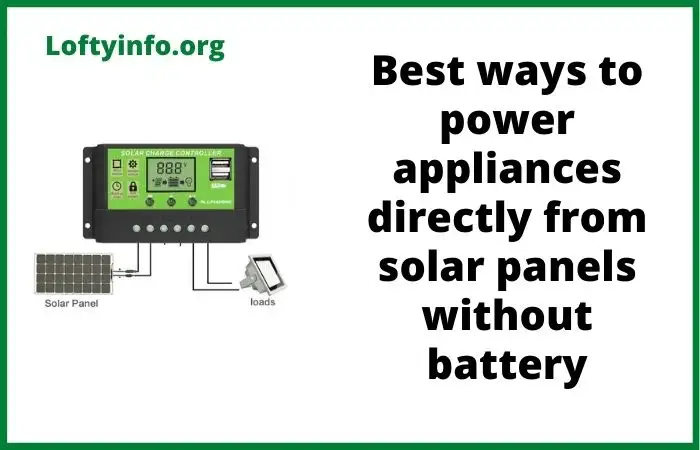Types of Solar Panels and Best Conditions To Use Each Type
Solar panels come in various types.
Each type is designed with specific characteristics that make them suitable for different applications and environmental conditions.
Understanding these differences helps in selecting the right solar technology for your specific needs and location.
In this guide, the different types of solar panels will be explained with the best conditions to choose each.
This will help get value for your money as well as optimal performance from the solar system.
Types of Solar Panels and Best Conditions To Use Each Type
1. Monocrystalline Solar Panels
Monocrystalline solar panels are made from single-crystal silicon created through the Czochralski process where a silicon seed crystal is slowly pulled from molten silicon.
This manufacturing method produces uniform, dark colored cells with rounded corners easily recognizable by their sleek black appearance.
These panels typically achieve efficiency rates between 18-22% making them among the most efficient commercially available solar panels.
The single-crystal structure allows electrons to move more freely resulting in higher electrical output and better performance in various lighting conditions.
Monocrystalline panels also have excellent temperature coefficients meaning they lose less efficiency as temperature rises compared to other panel types.
Best Conditions for Monocrystalline Panels
1) Limited installation Space with High Energy Demands
Monocrystalline panels excel in residential and commercial installations where the installation space is small.
Their higher efficiency means you can generate more electricity per square foot making them ideal for urban homes or businesses that need maximum power output from a limited installation area.
2) Extreme Weather Conditions
These panels perform exceptionally well in harsh weather environments due to their robust construction and superior temperature coefficient.
In regions with frequent temperature fluctuations, heavy snow loads or extreme heat, monocrystalline panels maintain better performance and longevity compared to other types.
3) Low-Light and Partial Shading Conditions
Monocrystalline panels demonstrate superior performance in low-light conditions.
This includes shading from surrounding buildings and cloudy days.
Their single crystal structure allows for better electron flow even when sunlight is diffused making them perfect for regions with shorter daylight hours or frequent overcast conditions.
2. Bifacial Solar Panels
Bifacial solar panels are designed to capture sunlight from both the front and rear surfaces utilizing reflected light from the ground, nearby structures or snow.
They can increase energy yield by 10-30% compared to traditional monofacial panels, depending on installation conditions and reflectivity of the surrounding surface.
Most bifacial panels use monocrystalline or polycrystalline cells and can be mounted in various configurations including elevated ground mounts, tracking systems or vertical installations.
They typically have higher power-to-weight ratios and often come with extended warranties due to their robust construction.
Best Conditions for Bifacial Panels
1) Highly Reflective Environments
Bifacial panels perform exceptionally well in areas with highly reflective surfaces such as snow-covered regions, white rooftops, concrete surfaces or near bodies of water.
The reflected light significantly boosts the rear-side energy generation, maximizing the panel’s dual surface advantage and increasing overall system efficiency.
2) Elevated Ground-Mount Installations
These panels are ideal for utility scale solar farms or large commercial installations where they can be mounted on tracking systems or elevated structures.
The increased clearance from the ground allows better airflow for cooling and more reflected light to reach the rear surface, optimizing both front and back energy capture.
3) Areas with Consistent Direct and Indirect Sunlight
Bifacial panels excel in locations that receive both strong direct sunlight and substantial ambient light throughout the day.
Regions with clear skies but also good atmospheric light scattering such as high-altitude locations or areas with reflective terrain can maximize the benefits of dual sided energy capture.
3. Polycrystalline Solar Panels
Polycrystalline solar panels are manufactured from silicon crystals that are melted and poured into square molds, creating a multi-crystal structure.
This simpler manufacturing process results in panels with a distinctive blue color and visible grain boundaries.
While less efficient than monocrystalline panels typically achieving 15-17% efficiency, they offer a more cost-effective solution for many applications.
The multi-crystal structure creates some resistance to electron flow, slightly reducing efficiency but this manufacturing method requires less energy and produces less waste, making polycrystalline panels more environmentally friendly to produce.
They have good durability and typically come with 20-25 year warranties.
Best Conditions for Polycrystalline Panels
1) High Solar Irradiance Regions with Extended Sunlight Hours
Polycrystalline panels perform optimally in areas with abundant, consistent sunlight such as desert regions, tropical locations or areas with long summer days.
The extended exposure to high-intensity sunlight compensates for their lower efficiency, allowing them to generate substantial electricity throughout the day.
2) Large-Scale Installations with Ample Space
These panels are perfect for utility scale solar farms, agricultural installations or large commercial rooftops where space constraints are minimal.
Since more panels are needed to achieve the same output as monocrystalline systems, having adequate installation area allows for cost effective large scale deployment.
3) Budget Conscious Projects in Sunny Climates
Polycrystalline panels offer the best value proposition in regions with reliable, high solar irradiance where the lower upfront cost can be offset by consistent energy production.
They are ideal for developing markets, agricultural applications, or any project where initial investment costs are a primary concern but adequate sunlight is available.
4. Thin Film Solar Panels
Thin film solar panels are created by depositing photovoltaic material in thin layers onto substrates such as glass, metal or plastic.
Common thin film technologies include amorphous silicon (a-Si), cadmium telluride (CdTe) and copper indium gallium selenide (CIGS).
These panels are significantly lighter and more flexible than crystalline silicon panels, though they typically have lower efficiency rates of 10-12%.
The manufacturing process allows for large-scale production and integration into various surfaces and applications.
They function well in areas that require use of light weight panels.
Best Conditions for Thin Film Panels
1) Mobile and Portable Applications
The lightweight and flexible nature of thin film panels makes them perfect for RVs, boats, backpacking equipment and other mobile applications where weight and portability are crucial factors.
Their ability to conform to curved surfaces and withstand vibration makes them ideal for transportation and outdoor adventure applications.
Thin film solar panels are easily carried around.
This makes it very efficient for use to campers and people using an RV to reduce weight on the RV roof.
2) High Temperature Environments
Thin film panels have superior temperature coefficients, losing less efficiency as temperatures rise compared to crystalline panels.
They’re excellent for hot climate installations, building-integrated applications with limited ventilation or industrial settings where ambient temperatures are consistently high.
5. Building Integrated Photovoltaics (BIPV)
Building Integrated Photovoltaics (BIPV) are solar panels designed to replace conventional building materials serving dual functions as both building envelope and electricity generator.
These systems can be integrated into roofs, facades, windows, skylights or shading structures.
BIPV products include solar roof tiles, transparent solar windows, solar facades and solar canopies that blend seamlessly with architectural design.
BIPV systems offer aesthetic appeal while providing energy generation, often using various technologies including crystalline silicon, thin film or emerging organic photovoltaics.
While they may have slightly lower efficiency than traditional rack-mounted systems due to integration constraints, they provide additional value through building material cost offsets and architectural benefits.
Best Conditions for BIPV Systems
1) New Construction and Major Renovations: BIPV systems are most cost effective when integrated during initial building construction or major renovation projects.
The ability to replace conventional building materials while generating electricity provides the best return on investment as it eliminates both material and labor costs for traditional roofing or facade materials.
2) Urban Environments with Aesthetic Requirements: BIPV excels in cities, historic districts or areas with strict architectural guidelines where traditional solar panels might be prohibited or aesthetically undesirable.
These systems allow property owners to generate renewable energy while maintaining architectural integrity and complying with local building codes or homeowner association requirements.
3) Buildings With Limited Space
One of the greatest reasons why building integrated photovoltaics is used is due to space.
This is highly applicable in high rise buildings that require high power but have less space for solar panels installation.
When this occurs, building integrated photovoltaics are used in place of wall renderings on the sides of the building.
Solar roof tiles and shingles are also used in place of normal roofing materials like aluminium zinc.
This helps in generating enough power for use irrespective of how limited the space in the building area is.






